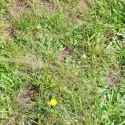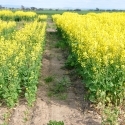13 Oct 2016
Looking back on nutrition issues from 2016
Summaries from Westmere, Keith, Conmurra and Frances Field Days
 Southern Farming Systems Research Site
Southern Farming Systems Research Site
At present (mid-spring) we have faced some challenging conditions, in particular long periods of wet conditions, waterlogging, limited opportunities for nutrient application – but where waterlogging has not been severe – high crop yield potentials. There are still things that can affect the final outcome but growers are well place to achieve the record winter crop production predicted by ABARES of just over 46 Mt.
As we move towards harvest, there has been another year of lessons that we can take away. Using these lesson, we can build a framework within which a plan for nutrient management can be built and HOPE is not a plan.
The first and most obvious thing is to get the basics RIGHT – is the pH OK, are there areas of B toxicity, does the soil crust and need gypsum – “silk purses from sow’s ears”. Is the crop sown on time, is the establishment good?
In terms of nutrient management, we think about 4 R nutrient stewardship – the 4 R’s are – selecting the RIGHT nutrient source, applying them at the RIGHT rate, supplied at the RIGHT time and put in the RIGHT place. This year there are a few lessons on 4R stewardship from 2016 in particular.
Selecting the right nutrient source – it may be composts, manures, mineral fertilizers, fluids. Whatever you use, it needs to supply the nutrient that is most limiting. Soil testing is a critical part of this – identifying the limit – there are some important aspects here:
- · Ensure there is a soil testing program in place to assess the trends in nutrient status – take samples to the right depth and send them to accredited labs. Soil tests help identify the nutrient most likely to be limiting – and this is the first one to address.
· Limits change with different systems – for example where it is an appropriate strategy, subsoil manuring or claying raises the yield potential so both rate and source of nutrients need to be considered. In particular, more P and N may be need to address the higher yield potential.
· Diagnosis is an important part of identifying the RIGHT source - Tissue tests are a good strategy if problems arise – take samples from good and bad areas and compare. Take the right tissue at the right time.
· We have seen some unusual symptoms this year – associated with the wet conditions, and the chemistry in the soil.
- o Manganese toxicity has shown up – commonly on acid soils – pHCa<5. Symptoms in canola can be confused with S deficiency and this is where diagnosing is more than just looking – tissue tests and the situation help. Light soils where S leaches suggest S rather than MnTox. There is no treatment to alleviate this – but consider this as a reminder that liming is probably something that should be on the plan.
o At the other end of the spectrum we have also seen Manganse deficiency on soils overlying or with high levels of limestone. As the Keith field day, there were symptoms of Mn deficiency in oats (in particular) – situation is a light soil over limestone. Not surprising as this area reported the first micronutrient deficiency in Australia in the 1920’s – which was of Mn in oats – called “roadside take-all” – lime blowing off roads and reducing Mn availability.
o There have also been issues with particular leaf yellows symptoms – most commonly with cultivars that have B tolerance genes and in some way this seems to disrupt Cl metabolism. Such interactions among nutrients and cultivars do occur and again – checking to get some tissue tests will help diagnose. There is no treatment - but there also appears to be not much effect on yield. For more information I have loaded the AGT bulletin for download.
o On lighter soils under wet conditions, sulfur deficiency can occur because of the mobility of this nutrient moving beyond the rootzone. Even where soil test values at seeding are OK, the wet season can result in deficiency.
o Magnesium deficiency has been seen on lighter acid soils – and this is difficult to diagnose without tissue tests – but when seen, again the solution is to look at liming – maybe with dolomitic limestone.
· The appearance of header or windrow tracks across the paddock are also good guides to potential K deficiency – something of a rising issue for the HRZ (my opinion). There is good growth in these strips and while topdressing is OK, using drilled K in the next crop will be much more efficient than waiting to the symptoms appear – from WA – topdressed is about one quarter as efficient as at seeding.
- · For N – have a rate that will supply 40 kg N/t of wheat, or 80 kg N/t of canola. Discount that amount by pre-sowing N values and an estimate of in-crop mineralisation. This is a difficult decision as mineralisation increases available N, but loss processes (denitrification, leaching, immobilization) all are in play.
- o Using an N rich strip is a great option – it gives a visual assessment of the amount the soil is supplying from mineralisation.
o Volatilization of surface applied N dwells on our minds with dry conditions but in reality the losses are modest, and denitrification has been a far bigger issue due to episodic waterlogging.
o It is reasonable to assume that the Nitrate-N content was largely reset to zero by the time the paddock dried. Until N is nitrified from ammonium some N to fill the gap may be important. Getting N on as soon as possible will give the crop the best opportunity to recover – there is not much point putting on N where there is standing water as it really cannot be taken up and can drain away.
- o For P – because timing options are limited to at-sowing the P, the usual practice is removal plus a little as many soils are at maintenance P fertility – 30 to 50 Colwells. P removal is about 3 kg P/t of wheat and 5 kg P/t of canola. There are differences among crops (and cultivars) with their ability to access different P pools in the soil, and monitoring this with soil tests is important, as the amount in the less available pools will affect the amount in the more available pools.
o Replacement plus strategy is still a good approach. The amount plus will depend on the soil PBI and any soil erosion losses, and for PBI less than – say – 150 an extra 1-2 kg P is probably adequate to maintain soil test levels. Given high P removals in 2016, upwards adjustments to P rates may need to be considered for the 2017 cropping season.
- o So a 6 t/ha wheat crop with the stubble burned would remove 90 kg K/ha and if the stubble was cut and carted about twice that amount removed.
Selecting the right timing – in synchrony with the demand of the crop – the safest place for nutrients is in the barn or in the crop – some are mobile (eg N &S) while P and K are less mobile so losses by leaching are less likely – but on lighter sands everything moves. Timing is about minimizing the potential losses – but some crops differ in their response to later nutrients
- · Wheat and canola are pretty good at compensating for early sulfur and nitrogen deficiencies – but there are other things that come to play such as weed competition due to early vigour. It was also clear that early sown, and so well grown crops – were much better at coping with the flooding that came their way (within reason).
· What about late N for protein – a matter of great balance. The pinch points are that
- o the crop really needs more N (leaf symptoms, N-rich strip)
o that N can be supplied to the crop – later applications are less efficient than earlier applications
o can enough N be supplied to increase protein - to raise the protein content of 5 t/ha wheat crop 1% with a 50% efficiency of N use (high) - is 20 kg N.
o is the current protein estimate near enough to get benefit from a 1% protein increase or will it just go from 8.5% to 9.5% without achieving a grade change.
o the N supplied is late enough (GS60+) that the N goes to grain not yield. N uptake and remobilization finishes earlier than carbohydrate deposition.
o With a long and cool finish, carbohydrate synthesis will continue giving larger grain size, so the benefit may end as higher yields rather than higher protein.
· Where soils are strongly binding to nutrients – such as Cu and high organic matter, applying it as a foliar and even quite late is a good strategy.
- · topdressed N can get stranded in the topsoil if there is little rain to wash it into the root zone – while some is lost through volatilization, the losses are generally small (<20%). The lack of response is mainly due to lack of access as in many cases much of the N will be recovered in the following crop.
· Paddock zoning – is the obvious one – using pH maps to direct liming is a great strategy, and using drones or some other sensing technologies can really help focus on areas that might require different strategies – this might mean using N sources with added sulfur on sandy soils, or patching off areas that have inadequate plant density to get a response.
· Fertilizer banding at seeding – bands are good as nutrient release from them is generally slower – but having seeds in them is not so good. Damage can occur with wide rows, light soils, heavy rates, dry conditions and N sources in particular, but K is also a culprit.
So there are the 4 R’s – match the right source applied at the right rate, supplied at the right time and in the right place.
Despite these observations, there are still things we have seen this season that are not easily explained. Physiological issues such as leaf yellows, alternating cold and warm conditions meaning awns can get trapped in the boot, leaf bronzing maybe due to frost, tearing of leaves due to wind, veinal striping of leaves maybe due to the good conditions - not everything is nutritional in origin so accurate diagnosis is critical to identify the next steps in the plan.
Additional Resources
AGT wheat yellows bulletinSize: 0.63 MB




